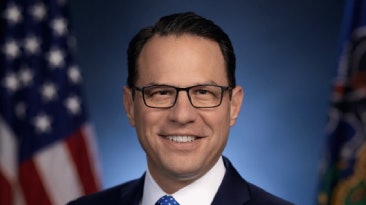Pennsylvania Gov. Josh Shapiro has released a new blueprint for higher education in the state, focused on competitiveness and workforce development, and grounded in access and affordability.
 Gov. Josh Shapiro
Gov. Josh Shapiro
“Every Pennsylvanian deserves the freedom to chart their own course and the opportunity to succeed,” said Shapiro, noting that 30 years of disinvestment has left many colleges and universities slim in finances and few students with affordable pathways through college and into good jobs.
Pennsylvania spends less on higher education than every other state except for New Hampshire, according to the Governor’s Office. That means the financial burden of higher education falls on the state’s institutions and students, who are forced to cut services, raise tuition, and take on more debt.
Pennsylvania's State System of Higher Education (PASSHE) enrollment has dropped 30% and community college enrollment has decreased by 37% over the past decade, officials reported. Colleges are competing with one another for limited dollars — duplicating degree programs, driving up costs, and reducing access.
Shapiro brought together a working group of higher education leaders and engaged stakeholders across the Commonwealth to examine these significant challenges and offer recommendations for a path forward. The result of their input is a three-part blueprint for higher education:
1. Creating a new system to address Pennsylvania’s needs
Shapiro’s plan will build a new system for higher education that unites the state’s PASSHE universities and 15 community colleges under a new governance system, preserving local leadership while uniting both types of institutions behind the goal of educating Pennsylvania.
Together, PASSHE and the state’s community colleges will be able to create pathways to affordable credentials and degrees that students can access throughout their lifetimes, improve coordination between schools, and serve as the most affordable higher education option for Pennsylvania students.
Shapiro plans to propose, in his Feb. 6 budget address, a significant investment in state-owned universities, community colleges, and the students they serve.
2. Increasing access and affordability
Once the new system is in place, Shapiro’s plan will make significant investments to ensure higher education is both affordable and accessible for all. Pennsylvanians making up to the median income will pay no more than $1,000 in tuition and fees per semester at state-owned universities and community colleges. The plan is expected to increase PHEAA grants for all students by $1,000.
3. Increasing transparency and improving outcomes
 Dr. Neeli Bendapudi
Dr. Neeli Bendapudi
Higher education leaders throughout the Commonwealth, including Penn State President Neeli Bendapudi, have embraced a performance-based funding model.
“I have been a strong advocate for performance-based funding in higher education, not only to enhance transparency and accountability, but also to achieve meaningful outcomes for our students,” said Bendapudi. “I am extremely pleased to see that part of Gov. Shapiro’s blueprint is a call to establish a predictable performance-based funding formula, and we look forward to working with the legislature to implement such a model. This initiative presents a significant opportunity for Penn State and other state-related institutions to work together with the Commonwealth on shared goals for workforce and economic development.”
The Shapiro Administration plans to establish a predictable, performance-based funding formula that rewards public and state-related colleges and universities for achieving outcomes that benefit the Commonwealth. The formula will take into consideration factors including but not limited to increasing enrollment, the number of first-generation college students that receive credentials, and the graduation rate.


















